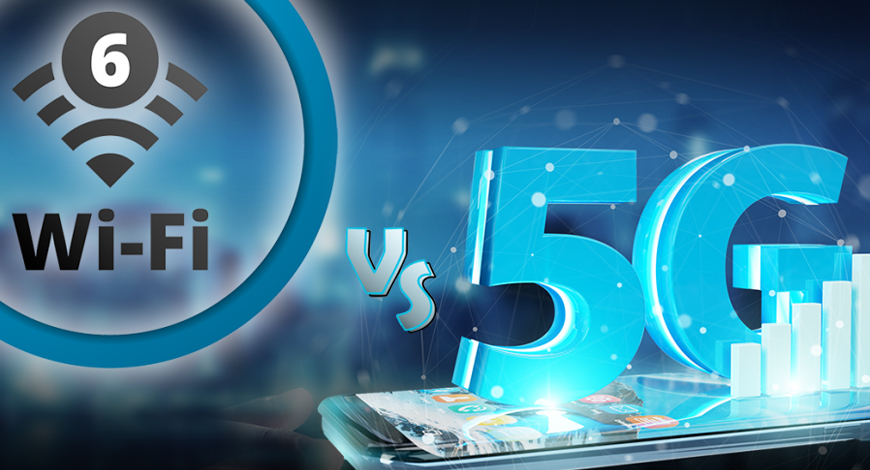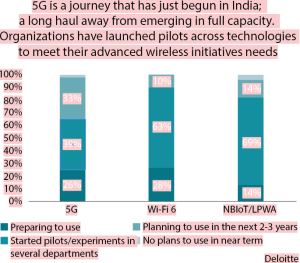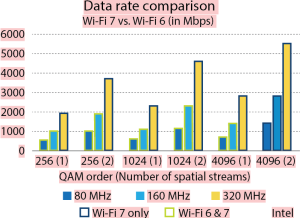CT Stories
Wi-Fi and 5G to coexist, yet true convergence a long way off

Wi-Fi 6 and 5G, different technologies, wireless LAN versus cellular, share some similarities, they represent the latest generation of technology in their respective spheres of influence, both offer tremendous promise, and can coexist.
5G seems to be overshadowing Wi-Fi 6. However, both will have a significant role to play in the future of wireless. Unlike past generations of wireless, 5G cellular and Wi-Fi 6 networks will be able to interoperate seamlessly with one another and are widely regarded as complementary technologies in the wireless ecosystem. Standards bodies and wireless alliances continue to propose solutions for the remaining technical challenges around seamless interoperability.
Networking executives report their enterprises are adopting both technologies for their wireless initiatives, indicating they prefer Wi-Fi 6 for indoor, on-campus, and fixed-network situations and 5G for outdoor, off-campus, and mobile-network environments. Adopting the technologies in parallel makes sense. Nearly all expect their organizations to be using both 5G and Wi-Fi 6 within the next two to three years. Projected investment reflects coadoption as well. Over the next three years, these organizations expect to split their wireless spending fairly evenly between Wi-Fi (48%) and cellular technologies (52%), says a Deloitte study.
Parallel adoption of 5G and Wi-Fi 6 is also apparent when we take a deeper look by country. While Wi-Fi 6 uses unlicensed spectrum (and, therefore, has a lower-cost path of entry), 5G initiatives generally require that government regulators auction or allocate spectrum suitable for 5G services.
In a perfect world, Wi-Fi and cellular would converge, and endpoints themselves would automatically select the appropriate network, based on predetermined policies, such as cost or performance.
There have been some early rumblings along those lines. The Wireless Broadband Alliance (WBA) and the Next-Generation Mobile Networks Alliance (NGMN) produced a report in 2021, promoting the future convergence between Wi-Fi and 5G. Similarly, the IEEE, sponsored by the Wi-Fi Alliance, has been discussing the potential pathways of convergence for a number of years.
As of now, however, true convergence seems a long way off.
In the next three years, organizations across India, China, and the United Kingdom are poised to place the highest priorities on 5G and Wi-Fi 6. Organizations are planning significant investments across hardware/equipment, devices, software, and installation along with operations services. Deloitte estimates that Indian organizations expect their three-year spending at ~USD 165 million (excluding spectrum fees) on an average, only next to Japan, making India one of the leading countries with the highest spend forecast.
To make an investment choice in deploying either 5G or Wi-Fi solutions, the essential role of Wi-Fi for providing high-speed, reliable, and affordable wireless broadband connectivity should be acknowledged. With significant potential benefits, both 5G and Wi-Fi are expected to work together, rather than compete, for an enhanced user experience. As of now, around 26 percent organizations surveyed by Deloitte are preparing to use both 5G and Wi-Fi 6 in varying capacities, such as acquiring devices/infrastructure, identifying potential providers, and building partnerships. While 39 percent organizations report that they already have started 5G-enabled pilots, around 63 percent have gone ahead with their experiments using Wi-Fi 6.

Wi-Fi carries more than half of today’s mobile data traffic and will continue to complement cellular LTE or 5G networks to serve critical business operations. Wi-Fi and 5G are strong complements in many next-generation connectivity scenarios. For example, the future of the digitally connected car will depend on a combination of cellular data services and in-vehicle Wi-Fi capabilities. The connected car might use in-vehicle Wi-Fi for connectivity between riders and streaming infotainment services, while the car itself may rely on 5G for vehicle-to-vehicle communication with someone in their carpool or to maintain a connection to cloud navigation services while driving down the highway. Wi-Fi and 5G together will accelerate next-generation connectivity trends, but next-generation use cases may require capabilities that are unique to one or the other. In particular, Wi-Fi 6 has a strong set of powerful advantages, and Wi-Fi’s overall inherent strengths like affordability, ubiquity, and ease of use make it the most compelling choice for certain use cases. Three areas where Wi-Fi brings a strong value proposition include indoor networking, Internet of Things (IoT) applications, and dense public deployments.
Wi-Fi will continue to be a predominant technology for home and business environments because it is affordable, easy to maintain and update, and has the ability to scale to accommodate multiple access points to serve more users. Indoors, Wi-Fi can accommodate large numbers of devices, and technologies including Wi-Fi 6 and Wi-Fi 6E provide higher data rates, greater capacity, efficiency, and coverage for the network. Wi-Fi 6 provides the foundation for a host of current and emerging indoor uses – from streaming ultra-high-definition movies to video conferencing and other business applications requiring high bandwidth and low latency. Wi-Fi also provides a robust connection with the ability to penetrate walls. Wi-Fi 6 now includes advanced features and delivers enhanced performance for emerging applications, such as virtual and augmented reality.
Wi-Fi offers advantages over cellular for IoT use cases. Wi-Fi is today’s technology of choice to connect users to the internet, and is an obvious choice when considering IoT technologies that connect devices to the internet and to each other.
Wi-Fi 6 has strong advantages for delivering high-density wireless services in public environments like concert venues and stadiums. Wi-Fi brings quality connectivity in locations with hundreds or thousands of connected devices, and Wi-Fi 6 helps ensure each connected device performs at an optimum level. Wi-Fi 6 delivers higher data rates, enabling a large number of connected users to more quickly access the network without lag time. Wi-Fi 6 also offers unprecedented capacity, allowing users in crowded environments to perform demanding applications while still receiving good Wi-Fi quality. Wi-Fi 6 and Wi-Fi 6E help deliver the optimal fan experience, and connectivity improvements during IPL matches were attributed to deployment of Wi-Fi.
Where and how users, enterprises, and network managers deploy Wi-Fi or 5G will likely depend on the use case, and Wi-Fi offers clear advantages for indoor networking, IoT applications, and dense public deployments. Wi-Fi is affordable and ubiquitous and is continually evolving to meet the connectivity demands of today and tomorrow.
Since its introduction in 2019, Wi-Fi Certified 6™ has seen rapid adoption, surpassing 50 percent market share in three years, compared to four years for Wi-Fi 5. This accelerated adoption is driven by demand for high performance Wi-Fi in phones, tablets, and PCs, and advanced features and capabilities are bringing new opportunities for IoT, service provider deployments, and dense public areas to deliver better experiences. Wi-Fi 6 extension into 6 GHz has further attributed to increasing demand, and Wi-Fi 6E has seen unprecedented interest among regulatory bodies worldwide, as well as strong adoption in products and in service provider and enterprise deployments. More than 2.3 billion Wi-Fi 6 products and 350 million Wi-Fi 6E products are expected to enter the market in 2022, and more than 15 percent of all Wi-Fi 6 shipments will also be Wi-Fi 6E this year.

In 2022, Wi-Fi Certified 6 added enhancements to best deliver advanced use cases. Wi-Fi 6 and Wi-Fi 6E are optimally equipped to meet today’s connectivity demands and allow a steady rate of new product and service innovation.
Two years ago, the US opened the 6 GHz band for Wi-Fi. Since then, more than 60 countries across Americas, EMEA, and APAC have or are considering making the band available for Wi-Fi. The Wi-Fi 6E ecosystem is expanding fast, and Wi-Fi 6E certification helps ensure worldwide interoperability for devices, no matter where they are deployed. Several countries, including Brazil, Canada, Chile, Costa Rica, Guatemala, Honduras, Peru, Saudi Arabia, South Korea, and the United Arab Emirates have made the upper and lower 6 GHz band (5925–7125 MHz) available for Wi-Fi 6E. By making the full band available, countries, such as Saudi Arabia, are looking to harness the full potential of Wi-Fi 6E, noting that Wi-Fi is crucial to their citizens. Other countries have opened the lower part of the band (5925–6425 MHz) and their efforts are being applauded, but Wi-Fi 6E and future generations will best deliver their full potential by using the entire 1200 MHz of spectrum in the 6 GHz band.
The global Wi-Fi 6 market size is expected to grow from USD 11.5 billion in 2022 to USD 26.2 billion by 2027, at a compound annual growth rate (CAGR) of 17.9 percent, according to MarketsandMarkets forecasts. The major vendors include Cisco Systems (US), Intel Corporation (US), Huawei Technologies (China), NETGEAR (US), Juniper Networks (US), Broadcom (US), Qualcomm Inc. (US), Extreme Networks (US), Ubiquiti Networks (US), Fortinet Inc. (US), Aruba Networks (US), NXP Semiconductors (Netherlands), AT&T (US), Cambium Networks (US), D-Link Corporation (China), Alcatel-Lucent (US), TP-Link (China), MediaTek (China), Telstra (Australia), Murata (Japan), Sterlite Technologies Limited (India), Celeno (Israel), H3C (China), Senscomm Semiconductor (China), XUNISON (Ireland), Redway Networks (UK), VSORA (France), NEWRACOM (US), WILUS Group (South Korea), and Federated Wireless (US). These players have adopted various growth strategies, such as partnerships, business expansions, mergers and acquisitions, agreements, and collaborations, and new product launches, to expand their presence in the Wi-Fi 6 market. Partnerships and new product launches have been the most adopted strategies by major players from 2019 to 2022, which helped them innovate their offerings and broaden their customer base.
Wireless local area network (WLAN) technology based on the IEEE 802.11 standard series is one of the most successful wireless communication technologies of the last two decades. Essentially based on an OFDM access scheme and typically operating on license-exempt bands, such as 2.4 GHz, 5 GHz and 60 GHz, it carries an essential portion of traffic from various devices in the wireless communications networks of today and tomorrow. The sixth generation of Wi-Fi (Wi-Fi 6), based on the IEEE 802.11ax standard, represents its improving communication efficiency and will be also operating in the newly available 6 GHz spectrum (Wi-Fi 6E). Moreover, the standardization of the seventh generation (Wi-Fi 7) has already started, with the target to enable extremely high throughput (IEEE 802.11be).
Wi-Fi 7 was developed with a focus on Wi-Fi extremely high throughput, which refers to its projected ability to support up to 30 Gbps throughput, roughly three times faster than Wi-Fi 6.
However, the next generation of Wi-Fi has a lot more to celebrate than just speed. Wi-Fi 4 and 5 were really all about feats of speed. Wi-Fi 6 brought vast improvements in scheduling and multi-user benefits. These features led to significant increases in Wi-Fi network capacity, lowered latency, and increased throughput because access points could allocate airwaves on demand to meet the needs of each individual user and application. A single transmission could serve multiple users at one time. Wi-Fi 7 doubles down on these innovations.
Beyond the multi-user and scheduling capabilities, Wi-Fi 7 will layer in high reliability, both in terms of throughput and latency, making it more suitable for the most demanding applications, particularly in the enterprise space. Already challenging because of the density of APs, number of users and diversity of applications, enterprise applications will become even more complex as they continue to add AR/VR, IoT, and IIoT applications to their workflows, all of which require deterministic latency, high reliability and quality of service (QoS).
In residential settings, Wi-Fi 7 will improve user experiences throughout the whole home for things like gaming, streaming, and other smart-home devices and services.
Broadly, Wi-Fi 7 will deliver whole-premises coverage with range enhancements and higher performance, even in the most demanding environments.
While there are huge expectations from 6 GHz spectrum, it is not Wi-Fi 6E, but rather Wi-Fi 7 that will usher in widespread adoption of unlicensed Wi-Fi use in the 6 GHz band, says Tam Dell’Oro, founder and CEO, Dell’Oro Group. Manufacturers shared with the analyst group that 6E shipments are coming in below expectations. This paired with supply constraints, spectrum-compliance hurdles and the impending release of Wi-Fi 7 enterprise-grade products, led the firm to conclude in its latest Wireless LAN 5-Year Forecast Report that many users will bypass Wi-Fi 6E.
And because Wi-Fi 6E products have more of everything – more radios, more processors, etc. – getting them manufactured at scale will be more of a challenge. If it is Wi-Fi 6 that enterprise customers are asking for, and components are limited, manufacturers will likely – and should – prioritize the production of Wi-Fi 6 products, says Dell’Oro. Lastly, with MediaTek’s public demonstration of consumer Wi-Fi 7 chips in January, Dell’Oro believes that enterprise-class products are right around the corner. More specifically, such products are expected to begin shipping as soon as 2023.
“If you look at the signals, the direction they’re pointing to is that 7 is going to be the upgrade; 6E is going to be the niche,” summarized Tam Dell’Oro.















You must be logged in to post a comment Login